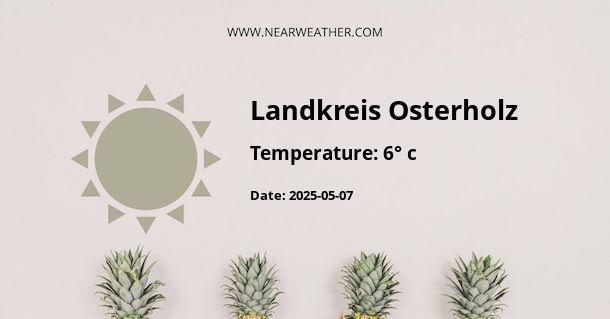Climate and Weather in Landkreis Osterholz, Germany
Landkreis Osterholz, located in the northwestern part of Germany, features a temperate oceanic climate with mild differences between highs and lows, and there is adequate rainfall year-round. This report will provide a comprehensive overview of the climate patterns, monthly weather statistics, and unique weather phenomena of Landkreis Osterholz.
General Climate Overview
The climate in Landkreis Osterholz, as in much of Northern Germany, is heavily influenced by its proximity to the North Sea. The North Atlantic Drift, a powerful warm ocean current, plays a pivotal role in moderating temperatures throughout the year.
The Koppen climate classification for this region is Cfb, indicating a temperate oceanic climate.
Seasonal Weather Patterns
Spring (March - May)
Spring in Landkreis Osterholz brings a gentle reawakening of flora and fauna. The temperatures gradually increase, but the weather can still be quite changeable and sometimes unpredictable.
- March: Average high temperatures range from 8°C to 10°C, while average lows hover around 0°C to 2°C. Precipitation averages at about 50mm.
- April: Average high temperatures are between 12°C and 15°C, with lows ranging from 2°C to 4°C. Rainfall typically decreases slightly in April.
- May: It becomes significantly milder with average high temperatures at 16°C to 20°C, and lows at 6°C to 8°C. It's a relatively dry month, with an average 55mm of rainfall.
Summer (June - August)
The summer months are characterized by longer days and a general upturn in temperatures, creating ideal conditions for outdoor activities.
- June: Average highs sit between 19°C and 22°C, with lows of 10°C to 12°C. Precipitation increases slightly compared to spring.
- July: The warmest month, with average high temperatures between 22°C and 25°C, and average lows are generally around 13°C to 15°C. Rainfall is variable, with sudden showers being common.
- August: Temperatures usually range from high 20°C to low 14°C, similar to July. It is one of the wettest months of the year, with precipitation averages around 70mm.
Autumn (September - November)
Autumn witnesses a steady drop in temperatures and daylight hours. The transformation of the landscape with the changing foliage is notable.
- September: Average highs start to cool down to 17°C to 19°C, while lows dip to 9°C to 11°C. Rainfall averages around 60mm.
- October: A noticeable decline in temperatures with highs of 13°C to 15°C and lows of 5°C to 7°C. The weather becomes predictably wetter, with around 70mm of rain.
- November: Marked by a further temperature drop with average highs of 8°C to 10°C and lows hovering around 2°C to 4°C. The month has similar precipitation levels to October.
Winter (December - February)
Winters are cool and temperatures can occasionally dip below freezing.
- December: Average high temperatures are cold, between 4°C and 6°C, with average lows at -1°C to 1°C. This month experiences some of the highest precipitation, averaging 80mm.
- January: It’s the coldest month, where the highs average around 3°C to 4°C, and lows are -2°C to 0°C. Snowfall can occur, but significant accumulation is rare.
- February: Similar to January, with marginal increases in the high temperatures (4°C to 5°C) and slight increases in the low temperatures (-1°C to 0°C). Precipitation is typically around 50mm.
Annual Weather Statistics
| Month | High / Low | Precipitation |
|---|---|---|
| January | 3°C / -2°C | 60mm |
| February | 4°C / -1°C | 40mm |
| March | 8°C / 0°C | 50mm |
| April | 12°C / 2°C | 40mm |
| May | 16°C / 6°C | 55mm |
| June | 19°C / 10°C | 65mm |
| July | 22°C / 13°C | 70mm |
| August | 22°C / 14°C | 70mm |
| September | 19°C / 11°C | 60mm |
| October | 14°C / 7°C | 70mm |
| November | 8°C / 2°C | 70mm |
| December | 5°C / 0°C | 80mm |
Unique Weather Phenomena and Concerns
In the broader Bremen area, which includes Landkreis Osterholz, certain weather phenomena can occur, such as:
- Sturmtief: Occasionally, strong storm systems, known locally as Sturmtief, can cause gale-force winds particularly in the winter months. These can disrupt services and pose risks to infrastructure.
- Nebel: Fog (Nebel) is another occasional visitor due to proximity to the rivers and the sea, particularly during autumn and winter mornings.
- Schneefall: Snowfall (Schneefall) can be seen during the winter, but large accumulations are relatively rare. However, when snow does settle, it can lead to transportation challenges.
- Hitze Wellen: Heat waves (Hitze Wellen) are becoming more common due to climate change, with record-breaking summer temperatures presenting health risks, especially to vulnerable populations.
Climate Change Considerations
Climate change is influencing weather patterns in Landkreis Osterholz, as it is across the world. A trend toward more extreme weather events, including heat waves in the summer and intense rainfall leading to flooding, has been noted by climate researchers. Ensuring adaptive measures and sustainable practices are essential for the long-term maintenance of the region's environmental integrity and the health of its inhabitants.
Summary
The climate of Landkreis Osterholz is emblematic of the northern European maritime experience. A mild and moist climate prevails, with temperature extremes being moderated by the North Sea's influence. Understanding the nuances of this climate is vital for the economic activities of the region, including agriculture, tourism, and infrastructure development. Preparedness for climate change and its associated challenges will remain a priority to safeguard the weather-dependent aspects of life in Landkreis Osterholz.
A - Landkreis Osterholz's Latitude is 53.263889 & Longitude is 8.823890.
A - Weather in Landkreis Osterholz is 0° today.
A - Climate Conditions in Landkreis Osterholz shows broken clouds today.
A - Humidity in Landkreis Osterholz is 97% today.
A - Wind speed in Landkreis Osterholz is 1.62 km/h, flowing at 227° wind direction. today.
